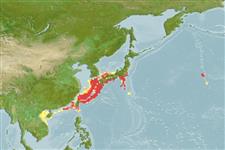>
Aulopiformes (Grinners) >
Aulopidae (Aulopus)
Etymology: Leptaulopus: Name from Greek 'leptos' meaning slender and 'aulopus' for a name long applied to the broader group of fi�shes to which the genusbelong; referring to the slender form of the speciesit comprises..
More on author: Tanaka.
Environment: milieu / climate zone / depth range / distribution range
Ecologie
marien demersaal; diepte 100 - 500 m (Ref. 51600). Subtropical
Western Pacific: Japan, East China Sea, Taiwan and Australia.
Grootte / Gewicht / Leeftijd
Maturity: Lm ? range ? - ? cm
Max length : 31.1 cm SL mannelijk / geslacht onbekend; (Ref. 94775)
Dorsale stekels (totaal): 0; Dorsale zachte stralen (totaal): 14; Anale stekels 0; Anale zachte stralen: 8 - 9. Distinguished from other Aulopus species of Japan in having fewer dorsal fin rays, and its orbit that is less than snout length. Second dorsal ray in males not prolonged; pyloric caeca 9-13 (Ref. 31559).
Levenscyclus en paargedrag
Maturiteit | Voortplanting | Paaien | Eieren | Fecunditeit | Larven
Gomon, M.F., C.D. Struthers and A.L. Stewart, 2013. A new genus and two new species of the family Aulopidae (Aulopiformes), commonly referred to as Aulopus Flagfins, Sergeant Bakers or Threadsails, in Australasian waters. Spec. Div. 18:141-161. (Ref. 94775)
Status op de Rode Lijst van het IUCN (Ref. 130435)
Gevaar voor de mens
Harmless
Gebruik door de mens
Meer informatie
Lokale namenSynoniemenMetabolismePredatorenEcotoxicologieVoortplantingMaturiteitPaaienPaaiaggregatiesFecunditeitEierenOntwikkeling van de eieren
Leeftijd/GrootteGroeiLengte-gewichtLengte-lengteLengtefrequentiesMorfometrieMorfologieLarvenLarvale populatiedynamiekRekruteringAbundantieBRUVS
ReferentiesAquacultuurAquacultuurprofielKweeklijnenGeneticaElectrophoresesErfelijkheidZiektesVerwerkingNutrientsMassaconversie
Tools
Speciale rapporten
Download XML
Internetbronnen
Estimates based on models
Preferred temperature (Ref.
123201): 4.1 - 20.2, mean 15.2 °C (based on 50 cells).
Fylogenetische diversiteitsindex (Ref.
82804): PD
50 = 0.7500 [Uniqueness, from 0.5 = low to 2.0 = high].
Bayesian length-weight: a=0.00447 (0.00187 - 0.01067), b=3.12 (2.91 - 3.33), in cm total length, based on LWR estimates for this (Sub)family-body shape (Ref.
93245).
Trofisch niveau (Ref.
69278): 4.1 ±0.7 se; based on size and trophs of closest relatives
Fishing Vulnerability (Ref.
59153): Low to moderate vulnerability (28 of 100).
